Holistic Governance for Sustainable Public Services: Reshaping Government–Enterprise Relationships in China’s Digital Government Context
Abstract
1. Introduction
2. Background
2.1. Holistic Governance in the Digital Government Context
2.2. Reshaping Government–Enterprise Relationships Underpins Holistic Governance
3. Conceptual Framework and Method
3.1. Conceptual Framework
3.2. Method
4. Case Study Analysis
4.1. Case 1—China State Council App Project
4.1.1. Overview of Project
4.1.2. Framework Instantiation
4.2. Case 2—The Guizhou-Cloud Big Data Project
4.2.1. Overview of Project
4.2.2. Framework Instantiation
4.3. Case 3—The Zhejiang Internet Plus Government Service Project
4.3.1. Overview of Project
4.3.2. Framework Instantiation
4.4. Case 4—The Guangdong E-Governance Project
4.4.1. Overview of Project
4.4.2. Framework Instantiation
5. Cross-Case Analysis and Discussion
5.1. Comparison of Government–Enterprise Relations Under Holistic Governance
5.2. Comparison Analysis of Characteristics of Holistic Governance Processes
6. Conclusions
Author Contributions
Funding
Acknowledgments
Conflicts of Interest
References
- Osborne, S.P.; Radnor, Z.; Kinder, T.; Vidal, I. The service framework: A public-service-dominant approach to sustainable public services. Br. J. Manag. 2015, 26, 424–438. [Google Scholar] [CrossRef]
- Bolton, R.; Hannon, M. Governing sustainability transitions through business model innovation: Towards a systems understanding. Res. Policy 2016, 45, 1731–1742. [Google Scholar] [CrossRef]
- Boons, F.; Lüdeke-Freund, F. Business models for sustainable innovation: State-of-the-art and steps towards a research agenda. J. Clean Prod. 2013, 45, 9–19. [Google Scholar] [CrossRef]
- Linders, D. From e-government to we-government: Defining a typology for citizen coproduction in the age of social media. Gov. Inform. Q. 2012, 29, 446–454. [Google Scholar] [CrossRef]
- Etgar, M. A descriptive model of the consumer co-production process. J. Acad. Market. Sci. 2008, 36, 97–108. [Google Scholar] [CrossRef]
- Van den Boer, Y.; Pieterson, W.; Arendsen, R.; van Dijk, J. Towards a model of source and channel choices in business-to-government service interactions: A structural equation modeling approach. Gov. Inform. Q. 2017, 34, 434–456. [Google Scholar] [CrossRef]
- Nambisan, S.; Wright, M.; Feldman, M. The digital transformation of innovation and entrepreneurship: Progress, challenges and key themes. Res. Policy 2019, 48, 103773. [Google Scholar] [CrossRef]
- Von Danwitz, S. Organizing inter-firm project governance—A contextual model for empirical investigation. Int. J. Manag. Proj. Bus. 2018, 11, 144–157. [Google Scholar] [CrossRef]
- Gao, X.; Song, Y.; Zhu, X. Integration and coordination: Advancing China’s fragmented e-government to holistic governance. Gov. Inform. Q. 2013, 30, 173–181. [Google Scholar] [CrossRef]
- Felix, R.; Rauschnabel, P.A.; Hinsch, C. Elements of strategic social media marketing: A holistic framework. J. Bus. Res. 2017, 70, 118–126. [Google Scholar] [CrossRef]
- Hardi, P.; Buti, K. Corporate governance variables: Lessons from a holistic approach to Central-Eastern European practice. Corp. Gov. Int. J. Bus. Soc. 2012, 12, 101–117. [Google Scholar] [CrossRef]
- Cheung, E.; Chan, A.P.C.; Kajewski, S. The public sector’s perspective on procuring public works projects—Comparing the views of practitioners in Hong Kong and Australia. J. Civ. Eng. Manag. 2010, 16, 19–32. [Google Scholar] [CrossRef][Green Version]
- Ziemba, E. The ICT Adoption in Government Units in the Context of the Sustainable Information Society. In Proceedings of the 2018 Federated Conference on Computer Science and Information Systems (FedCSIS), Poznan, Poland, 9–12 September 2018. [Google Scholar]
- Ziemba, E. Exploring Levels of ICT Adoption and Sustainable Development—The Case of Polish Enterprises. In Proceedings of the Federated Conference on Computer Science and Information Systems (FedCSIS), Leipzig, Germany, 1–4 September 2019. [Google Scholar]
- Klijn, E.H.; van Twist, M.; van der Steen, M.; Jeffares, S. Public managers, media influence, and governance. Adm. Soc. 2016, 48, 1036–1058. [Google Scholar] [CrossRef]
- Hueskes, M.; Verhoest, K.; Block, T. Governing public–private partnerships for sustainability. Int. J. Proj. Manag. 2017, 35, 1184–1195. [Google Scholar] [CrossRef]
- Ju, J.; Liu, L.; Feng, Y. Public and private value in citizen participation in E-governance: Evidence from a government-sponsored green commuting platform. Gov. Inform. Q. 2019, 36, 101400. [Google Scholar] [CrossRef]
- Dunsire, A. Holistic governance. Public Policy Adm. 1990, 5, 4–19. [Google Scholar] [CrossRef]
- Warsen, R.; Greve, C.; Klijn, E.H.; Koppenjan, J.; Siemaitycki, M. How do professionals perceive the governance of public-private partnerships? Evidence from Canada, the Netherlands, and Denmark. Public Adm. 2019. [Google Scholar] [CrossRef]
- Rüffin, N. EU science diplomacy in a contested space of multi-level governance: Ambitions, constraints and options for action. Res. Policy 2020, 49, 103842. [Google Scholar] [CrossRef]
- Han, Z.; Yang, Y. Research and application of holistic governance theory. Teach. Res. 2013, 6, 80–86. [Google Scholar]
- Rummery, K. Partnerships and collaborative governance in welfare: The citizenship challenge. Soc. Policy Soc. 2006, 5, 293–303. [Google Scholar] [CrossRef]
- Janssen, M.; Klievink, B. The role of intermediaries in multi-channel service delivery strategies. Int. J. Electr. Gov. Res. 2009, 5, 36–46. [Google Scholar] [CrossRef]
- Li, H.; Wang, J.; Yang, X.; Wang, Y.; Wu, T. A holistic overview of the progress of China’s low-carbon city pilots. Sustain. Cities. Soc. 2018, 42, 289–300. [Google Scholar] [CrossRef]
- Scupola, A.; Zanfei, A. Governance and innovation in public sector services: The case of the digital library. Gov. Inform. Q. 2016, 33, 237–249. [Google Scholar] [CrossRef]
- Carruthers, J.I.; Ulfarsson, G.F. Fragmentation and sprawl: Evidence from interregional analysis. Growth Change 2002, 33, 312–340. [Google Scholar] [CrossRef]
- Stansel, D. Local decentralization and local economic growth: A cross-sectional examination of US metropolitan areas. J. Urban. Econ. 2005, 57, 55–72. [Google Scholar] [CrossRef]
- Cordella, A.; Bonina, C.M. A public value perspective for ICT enabled public sector reforms: A theoretical reflection. Gov. Inform. Q. 2012, 29, 512–520. [Google Scholar] [CrossRef]
- Watt, P.A. Information, cooperation and trust in strategic service delivery partnerships. Public Policy Adm. 2005, 20, 106–123. [Google Scholar] [CrossRef]
- Williamson, B. Knowing public services: Cross-sector intermediaries and algorithmic governance in public sector reform. Public Policy Adm. 2014, 29, 292–312. [Google Scholar] [CrossRef]
- Perri 6. Housing policy in the risk archipelago: Toward anticipatory and holistic government. Hous. Stud. 1998, 13, 347–375. [Google Scholar] [CrossRef]
- Kong, N. Integrated governance of fragmented community public services. J. Cent. China Norm. Univ. 2014, 53, 29–35. [Google Scholar]
- Huang, Y. Multi-level governance: Explaining the “climate-focused” behavior of Chinese exporting companies. Public Policy Adm. 2018, 34, 165–188. [Google Scholar] [CrossRef]
- Heidingsfelder, J. Private sustainability governance in the making–A case study analysis of the fragmentation of sustainability governance for the gold sector. Resour. Policy 2019, 63, 101462. [Google Scholar] [CrossRef]
- Jeffares, S.; Dickinson, H. Evaluating collaboration: The creation of an online tool employing Q methodology. Evaluation 2016, 22, 91–107. [Google Scholar] [CrossRef]
- Zheng, T.; Zheng, L. Examining e-government enterprise architecture research in China: A systematic approach and research agenda. Gov. Inform. Q. 2013, 30, S59–S67. [Google Scholar] [CrossRef]
- Zhang, J.; Liu, H.; Sayogo, D.S.; Picazo-Vela, S.; Luna-Reyes, L. Strengthening institutional-based trust for sustainable consumption: Lessons for smart disclosure. Gov. Inform. Q. 2016, 33, 552–561. [Google Scholar] [CrossRef]
- Singh, V.S.; Pandey, D.N.; Prakash, N.P. What determines the success of joint forest management? Science-based lessons on sustainable governance of forests in India. Resour. Conserv. Recy. 2011, 56, 126–133. [Google Scholar] [CrossRef]
- Zeng, F.; Wei, B. Holistic governance: Governance logic of service-oriented government. J. Guangdong Inst. Public Adm. 2010, 22, 22–25. [Google Scholar]
- Voegtlin, C.; Scherer, A.G. Responsible innovation and the Innovation of responsibility: Governing sustainable development in a globalized world. J. Bus. Ethics 2017, 143, 227–243. [Google Scholar] [CrossRef]
- Hu, J. Towards holistic governance: Holistic strategy for government reform and its applicability in China. Nanjing J. Soc. Sci. 2010, 5, 46–51. [Google Scholar]
- Geissel, B. Participatory governance: Hope or danger for democracy? A case study of local agenda 21. Local Gov. Stud. 2009, 35, 401–414. [Google Scholar] [CrossRef]
- Leat, D.; Seltzer, K.; Stoker, G. Governing in the Round. Strategies for Holistic Government; Demos: Xi’an, China, 1999; pp. 154–196. [Google Scholar]
- Emerson, K.; Nabatchi, T.; Balogh, S. An integrative framework for collaborative governance. J. Publ. Adm. Res. Theor. 2011, 22, 1–29. [Google Scholar] [CrossRef]
- Hu, X.; Tang, B. Holistic governance: A new paradigm of public management. J. Cent. China Norm. Univ. 2010, 49, 11–15. [Google Scholar]
- Wang, C.; Medaglia, R.; Zheng, L. Towards a typology of adaptive governance in the digital government context: The role of decision-making and accountability. Gov. Inform. Q. 2018, 35, 306–322. [Google Scholar] [CrossRef]
- Nakrošis, V.; Vilpišauskas, R.; Barcevičius, E. Making change happen: Policy dynamics in the adoption of major reforms in Lithuania. Inter. J. Environ. Res. Public Health 2018, 34, 431–452. [Google Scholar] [CrossRef]
- Janowski, T.; Estevez, E.; Baguma, R. Platform governance for sustainable development: Reshaping citizen-administration relationships in the digital age. Gov. Inform. Q 2018, 35, S1–S16. [Google Scholar] [CrossRef]
- Yang, G.; Xue, Y.; Ma, Y. Social Organization Participation, Government Governance and the Equalization of Basic Public Services: Evidence from China. Inter. J. Environ. Res. Public Health 2019, 16, 2996. [Google Scholar] [CrossRef]
- Börner, L.; Hegger, D.L.T. Toward design principles for sound e-waste governance: A research approach illustrated with the case of the Netherlands. Resour. Conserv. Recycl. 2018, 134, 271–281. [Google Scholar] [CrossRef]
- Aina, Y.A.; Wafer, A.; Ahmed, F.; Alshuwaikhat, H.M. Top-down sustainable urban development? Urban governance transformation in Saudi Arabia. Cities 2019, 90, 272–281. [Google Scholar] [CrossRef]
- Koopmans, M.E.; Rogge, E.; Mettepenningen, E.; Knickel, K.; Šūmane, S. The role of multi-actor governance in aligning farm modernization and sustainable rural development. J. Rural Stud. 2018, 59, 252–262. [Google Scholar] [CrossRef]
- Sun, Y.; van der Ven, H. Swimming in their own direction: Explaining domestic variation in homegrown sustainability governance for aquaculture in Asia. Ecol. Econ. 2020, 167, 106445. [Google Scholar] [CrossRef]
- Larsson, H.; Grönlund, Å. Sustainable eGovernance? Practices, problems and beliefs about the future in Swedish eGov practice. Gov. Inform. Q. 2016, 33, 105–114. [Google Scholar] [CrossRef]
- Niesten, E.; Jolink, A.; Lopes De Sousa Jabbour, A.B.; Chappin, M.; Lozano, R. Sustainable collaboration: The impact of governance and institutions on sustainable performance. J. Clean. Prod. 2017, 155, 1–6. [Google Scholar] [CrossRef]
- Li, C. From new public management to integral management. Ind. Sci. Tribune 2019, 18, 241–242. [Google Scholar]
- Sørensen, E.; Torfing, J. Metagoverning collaborative innovation in governance networks. Am. Rev. Public Adm. 2016, 47, 826–839. [Google Scholar] [CrossRef]
- Kanie, N.; Betsill, M.M.; Zondervan, R.; Biermann, F.; Young, O.R. A charter moment: Restructuring governance for sustainability. Public Adm. Dev. 2012, 32, 292–304. [Google Scholar] [CrossRef]
- Beisheim, M.; Ellersiek, A.; Goltermann, L.; Kiamba, P. Meta-governance of partnerships for sustainable development: Actors’ perspectives from Kenya. Public Adm. Dev. 2018, 38, 105–119. [Google Scholar] [CrossRef]
- Soma, K.; Termeer, C.J.A.M.; Opdam, P. Informational governance–A systematic literature review of governance for sustainability in the Information Age. Environ. Sci. Policy 2016, 56, 89–99. [Google Scholar] [CrossRef]
- Qu, Z.; Wu, Q. The precision expansion of holistic governance under the composite governance framework. Inn. Mong. Soc. Sci. 2020, 1, 004. [Google Scholar]
- Rasoolimanesh, S.M.; Badarulzaman, N.; Abdullah, A.; Behrang, M. How governance influences the components of sustainable urban development? J. Clean. Prod. 2019, 238, 117983. [Google Scholar] [CrossRef]
- Wagenaar, H. Governance, complexity, and democratic participation. Am. Rev. Public Adm. 2016, 37, 17–50. [Google Scholar] [CrossRef]
- Lupova-Henry, E.; Dotti, N.F. Governance of sustainable innovation: Moving beyond the hierarchy-market-network trichotomy? A systematic literature review using the ‘who-how-what’ framework. J. Clean. Prod. 2019, 210, 738–748. [Google Scholar] [CrossRef]
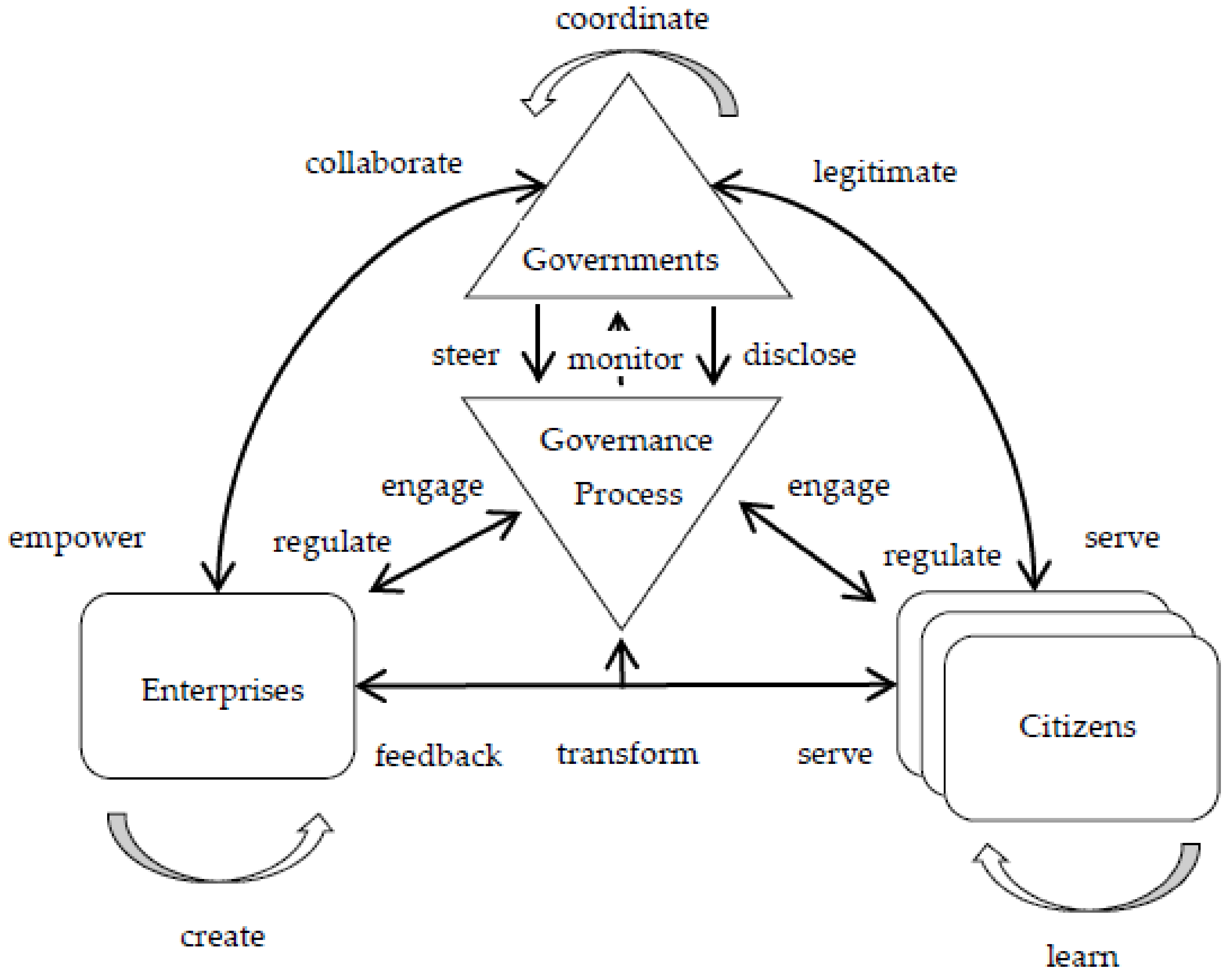
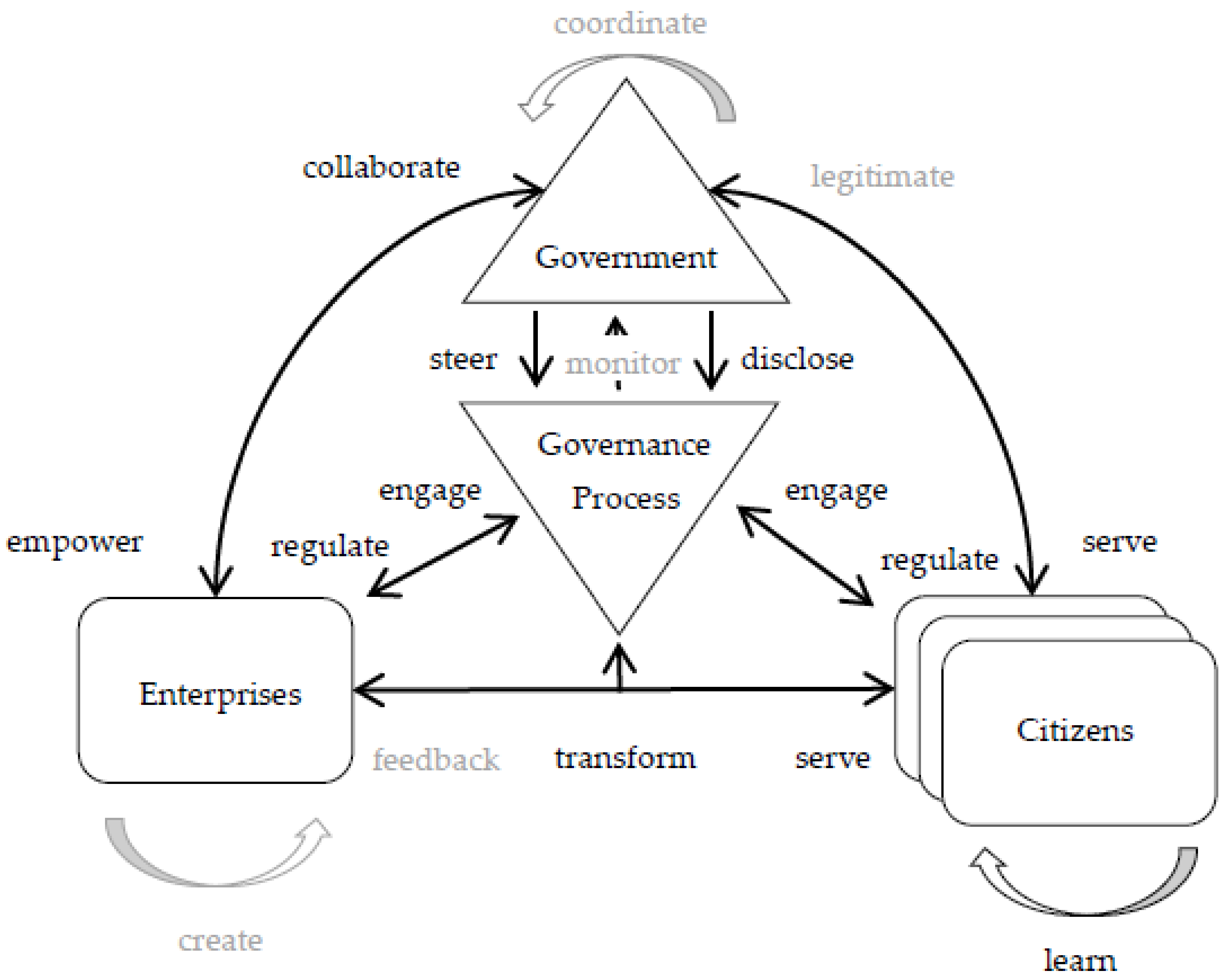
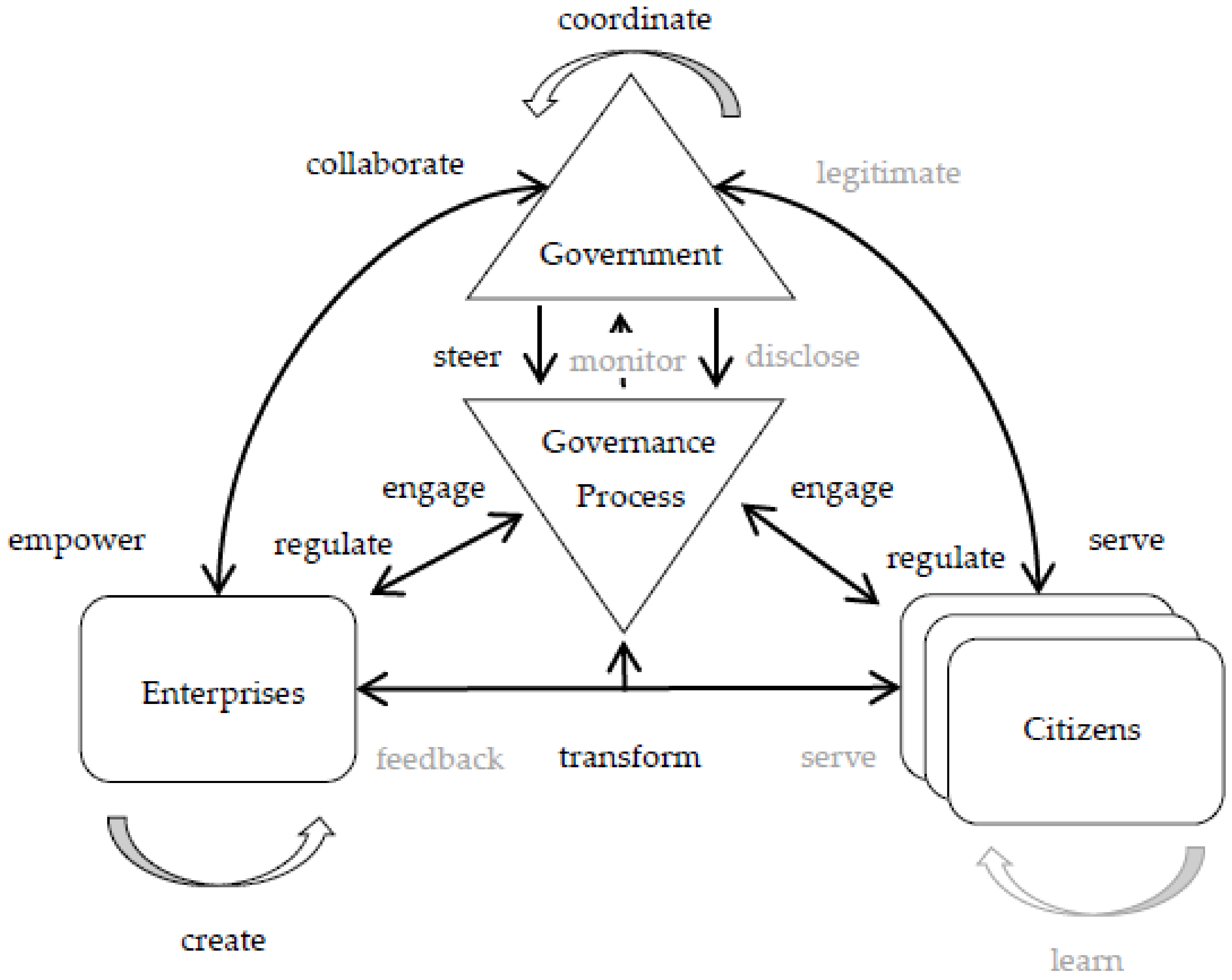
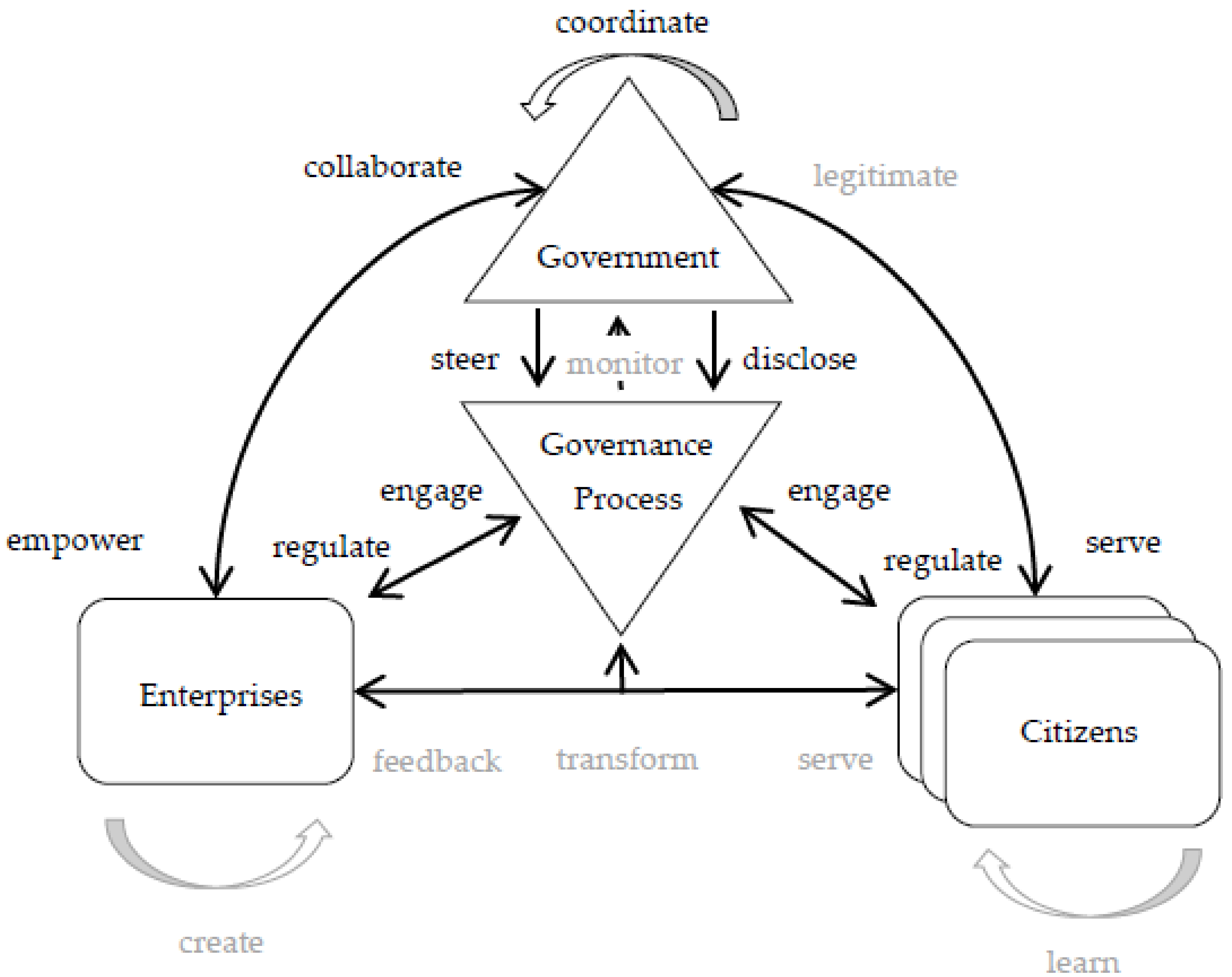
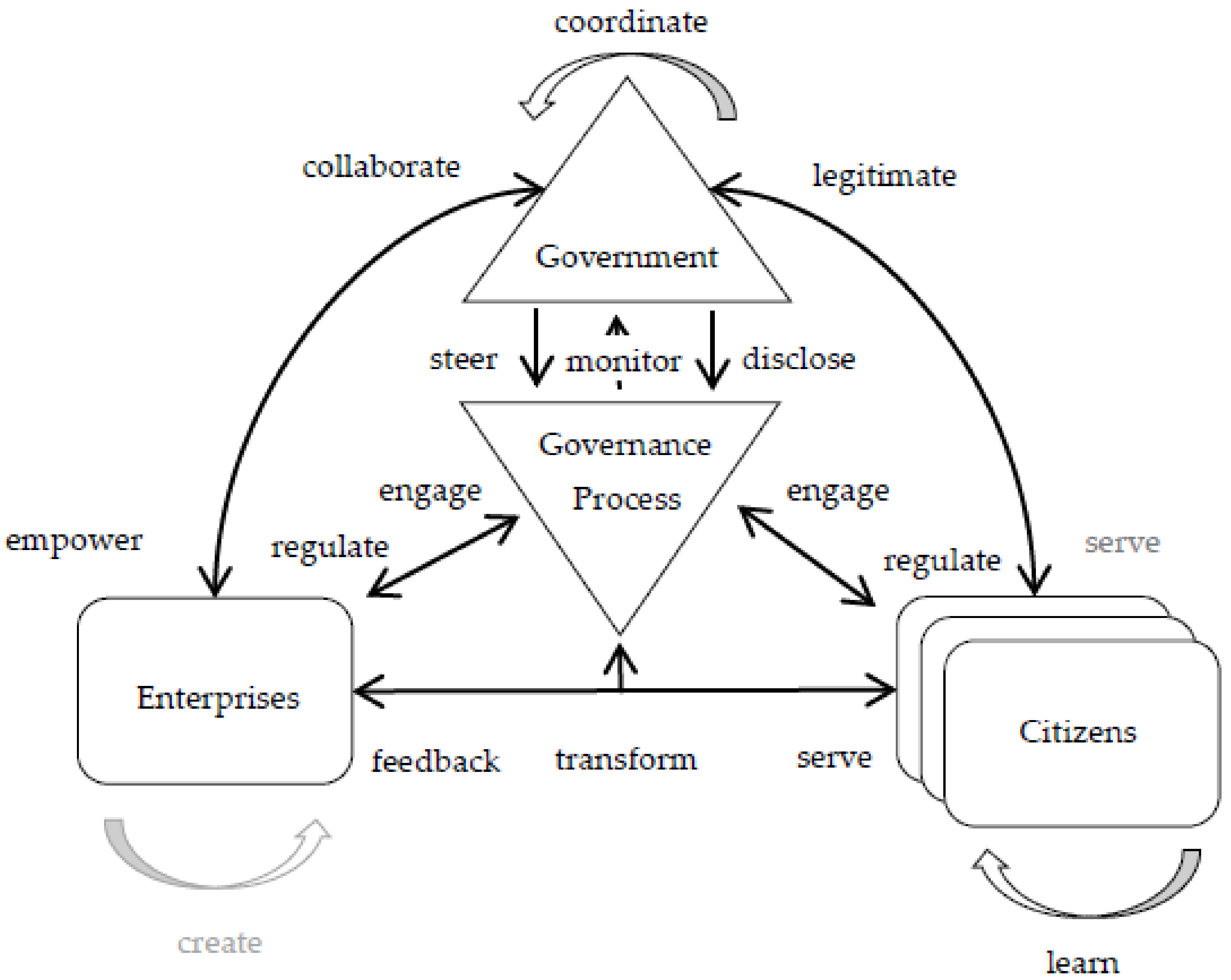
| Relationships | Definition | Source |
|---|---|---|
| Coordinate | The behavioral consistency of public actors to deal with complex things at various jurisdictional levels. | [49,50] |
| Collaborate | Government cooperate with enterprises and share and exchange the access to sources. | [51] |
| Empower | Governments create conditions for enterprises to take up decisions and actions by themselves. | [52] |
| Legitimate | Citizens and enterprises legitimize governments to act on their behalf. | [53] |
| Steer | Governments guide citizens and enterprises through various policy instrument. | [54] |
| Disclose | Governments open their decisions and operations to public scrutiny. | [55] |
| Monitor | Enterprises and citizens provide real-time supervision and accountability to governments through measurable policy evaluation system. | [56] |
| Engage | Governments engage enterprises and citizens in co-deciding public policies. | [57] |
| Transform | Governments achieve structural change and restructuring through adaptive learning. | [58] |
| Regulate | Governments restrict the conduct of enterprises and citizens to achieve policy objectives. | [59] |
| Feedback | Citizens report the service experience to the service provider. | [60] |
| Serve | In order to meet governance demand, governments establish a supply and demand relationship of public goods. | [61,62] |
| Create | Under the authority of the government, citizens and enterprises create public value for themselves and the community. | [63] |
| Learn | Bottom-up innovation and co-evolution of self-organized networks of organizations. | [64] |
| Id | Case | Main Resources |
|---|---|---|
| Case 1 | China state council APP project | http://www.gov.cn/xinwen/2017-02/09/content_5166775.htm |
| Case 2 | The Guizhou-cloud big data project | https://www.gzdata.com.cn/ |
| Case 3 | Internet plus government project | http://zwgk.gd.gov.cn/006939748/201604/t20160405_650520.html |
| Case 4 | The Guangdong e-governance project | http://www.echinagov.com/news/256550.htm |
| ID | Entities | Relationships | |||||||||||||||||
|---|---|---|---|---|---|---|---|---|---|---|---|---|---|---|---|---|---|---|---|
| Governments | Enterprises | Citizens | Governance Process | Coordinate | Collaborate | Empower | Legitimate | Steer | Disclose | Monitor | Engage | Transform | Regulate | Feedback | Serve | Create | Learn | Coverage (%) | |
| 1 | 2 | 3 | 4 | 5 | 6 | 7 | 8 | 9 | 10 | 11 | 12 | 13 | 14 | ||||||
| Case 1 | X | X | X | X | X | X | X | X | X | X | X | X | X | 64 | |||||
| Case 2 | X | X | X | X | X | X | X | X | X | X | X | X | X | 64 | |||||
| Case 3 | X | X | X | X | X | X | X | X | X | X | X | X | 57 | ||||||
| Case 4 | X | X | X | X | X | X | X | X | X | X | X | X | X | X | X | X | X | 92 | |
| Coverage (%) | 75 | 100 | 100 | 25 | 100 | 75 | 25 | 100 | 75 | 100 | 25 | 100 | 25 | 50 | |||||
| Characteristics | Case 1 | Case 2 | Case 3 | Case 4 |
|---|---|---|---|---|
| Number of governments | 4+ | 14+ | 8+ | 6+ |
| Number of non-governmental organizations (NGOs) | 10+ | 1 | 2 | 1 |
| Duration | 9 years+ | 2 years | 2 years | 2 years |
| Context | Digitalization | Digitalization | Digitalization | Transformation |
| Design | Application development based on information and communication technology (ICT) | Application development and development based on big data | Website development based on “Internet+” | Platform design based on WeChat |
| Motivation of holistic | Technological change | Technological change | Technological change | Process fragmentation |
| Insufficient participation | Process fragmentation | Financial deficit | ||
| Information disclosure | Administrative opacity | Poor user experience | ||
| Organization fragmentation economically backward | ||||
| Collaborate initiatives | Expanding network of partnerships | Cooperating with enterprises Developing big data industry | Standardizing process | Process reengineering |
| Public-private partnership | Outsourcing online service | |||
| Service patterns | Government-led | Government-led | Complementary | Enterprise-led |
| outputs | China State Council App | Guizhou-cloud App | Zhejiang Government Service Website | Guangdong’s City Services Platform |
| Skills covered from holistic Framework | Participation Coordination | Participation | Participation | Coordination |
| Coordination | System integration | Mobile participation | ||
| Data sharing | One-stop service | Service outsourcing | ||
| Big data analysis | Service marketization | Organizational restructuring |
© 2020 by the authors. Licensee MDPI, Basel, Switzerland. This article is an open access article distributed under the terms and conditions of the Creative Commons Attribution (CC BY) license (http://creativecommons.org/licenses/by/4.0/).
Share and Cite
Li, X.; Ding, Y. Holistic Governance for Sustainable Public Services: Reshaping Government–Enterprise Relationships in China’s Digital Government Context. Int. J. Environ. Res. Public Health 2020, 17, 1778. https://doi.org/10.3390/ijerph17051778
Li X, Ding Y. Holistic Governance for Sustainable Public Services: Reshaping Government–Enterprise Relationships in China’s Digital Government Context. International Journal of Environmental Research and Public Health. 2020; 17(5):1778. https://doi.org/10.3390/ijerph17051778
Chicago/Turabian StyleLi, Xuesong, and Yunlong Ding. 2020. "Holistic Governance for Sustainable Public Services: Reshaping Government–Enterprise Relationships in China’s Digital Government Context" International Journal of Environmental Research and Public Health 17, no. 5: 1778. https://doi.org/10.3390/ijerph17051778
APA StyleLi, X., & Ding, Y. (2020). Holistic Governance for Sustainable Public Services: Reshaping Government–Enterprise Relationships in China’s Digital Government Context. International Journal of Environmental Research and Public Health, 17(5), 1778. https://doi.org/10.3390/ijerph17051778




